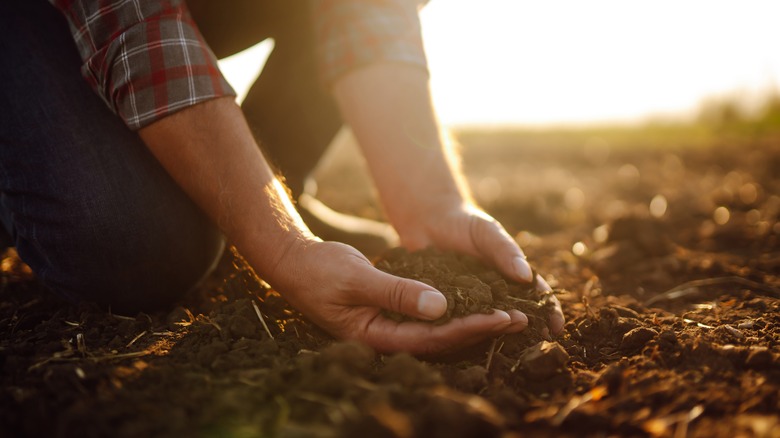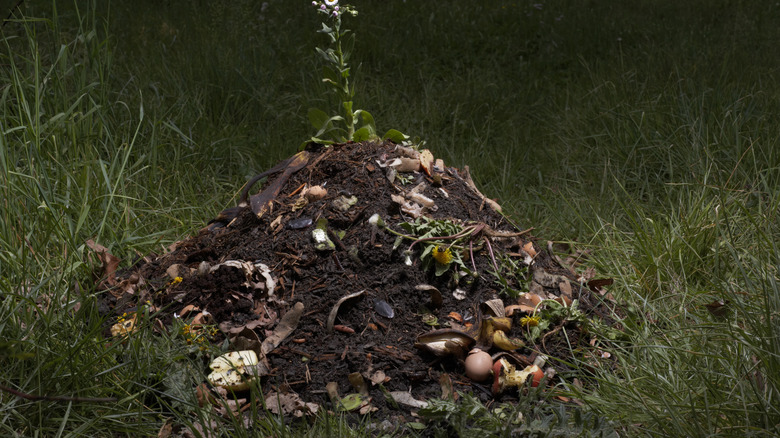The Easiest Way To Improve Sandy Soil For Gardening
Sandy soil is often seen as a challenge for gardeners for several reasons. Its coarse texture means that it drains very quickly, a quality that may seem advantageous but ultimately makes it difficult for plant roots to absorb the water they need. Nutrients also get washed away, making it less fertile. However, improving sandy soil is not an impossible task. You can improve its water-holding capacity, structure, and nutrient content by incorporating organic matter such as compost, biochar, or coconut coir.
Before you embark on a mission to improve your garden soil, you must have a good grasp of what type of soil you're dealing with. You wouldn't want to invest time, money, and energy into soil amendments only to find out later that you've been working with the wrong type of soil all along. Loamy soil is the gold standard for most garden plants because it retains moisture while also draining well, ensuring that plant roots receive adequate air and water. However, soil becomes sandy primarily due to the weathering of rocks and erosion. Over time, wind, water, and other natural elements break down larger rock particles into smaller granules. Sandy soil consists of larger, coarser particles, so it drains quickly and doesn't hold onto nutrients well. For you, as a gardener, understanding why your soil is sandy helps you take effective steps to improve its quality for better plant growth.
How to determine if you have sandy soil
You don't need fancy equipment or special kits to determine if you have sandy soil. Simply grab a handful of soil from different parts of your garden, add a little water to dampen it, and then try to roll it into a sausage-like shape. If you find that the soil just won't hold together and crumbles and disintegrates almost immediately, you're dealing with sandy soil. Identifying that you have sandy soil through this simple test means your garden lacks the water and nutrient retention capabilities that most plants need to flourish.
As mentioned, sandy soil absorbs water very quickly. Water runs through sandy soil like a sieve, taking vital nutrients and leaving your plants thirsty and malnourished. Your immediate goal should be to amend this soil to bring it closer to the loamy ideal, which retains enough moisture for plant roots to absorb what they need but still drains sufficiently to provide them with the necessary aeration. Achieving this balanced state will make your soil more hospitable to a broader range of plants, from vegetables to flowers, allowing your garden to survive and thrive.
Improving sandy soil: the power of organic matter
Organic matter is a gardener's best friend when it comes to improving any soil type, including sandy soil. Various types of organic matter are well known for their ability to retain a large amount of moisture, making them especially useful for sandy soils that drain too quickly. Compost and manure can slowly release moisture into your plants, making them ideal. Biochar is another effective option. It is made from organic matter, such as burned coconut husks. The result is charred material that is ground down into small pieces safe for garden soil. This organic matter improves not only water retention in sandy soils but also nutrient absorption. Lastly, coconut coir, which is composed of dried coconut hulls, is another excellent choice.
Once you have chosen your preferred organic matter, distribute it evenly over the soil surface to ensure maximum effectiveness. After this initial application, keeping an eye on your garden's performance over the next few months is crucial. Are your plants looking healthier? Is the soil retaining more moisture? If you do not see the improvements you desire, consider ramping up the frequency of organic matter applications to twice a year, possibly during the spring and fall. Do not hesitate to play around with the quantity of organic matter you use as well. If two buckets do not make a noticeable difference, increase the amount to three or even four bucketfuls per square yard. The idea is to continually assess and adjust until you find the optimal balance that your particular soil needs.


